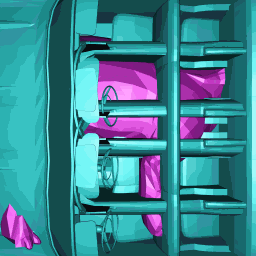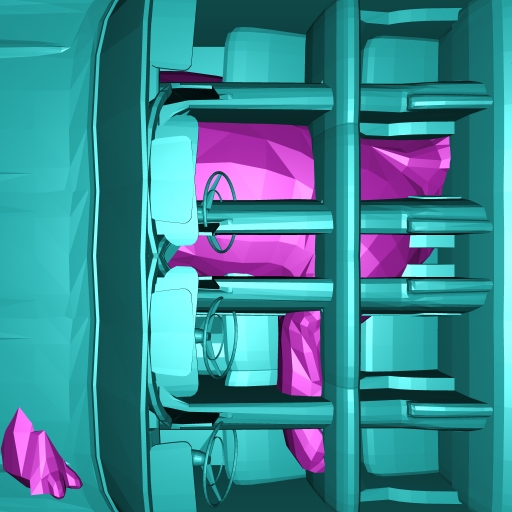 |
 |
RenderDude! contains 2 camera types, the Hierarchical Coverage Mask camera and the Z-buffer camera. In this section, we compare these two rendering algorithms, using image quality, speed, and memory usage. All benchmarking was done on the Frinkiac 2000, a 266Mhz PentiumII system with 128MB of memory.
The scene the I used for performance benchmarking depicts a bizarre situation in which 3 '57 Chevys (in blue) and 3 stegasauri (in pink) have somehow melded together. The scene describes 10 frames of animation in which the camera starts out in front of the cars and gradually backs out up and to the right. The very low-quality animated GIF below depicts the animation, and the still image on the right is a full size high quality version of the first frame of the animation, rendered with the HCM camera.
 |
 |
The scene consists of approximately 110,000 triangles. Vertex normals have been suppressed, so face normals are used for shading computations (hence the blocky shading effect).
The animation was rendered using both per-face and per-vertex (Gouraud) shading options with both the z-buffer and HCM cameras. In per-face shading, a random colour is chosen for each face, and the face is filled uniformly with that colour. For the HCM camera mode, both subpixel (64 visibility samples per pixel) and non-subpixel (1 visibility sample per pixel) were rendered for each shading mode. The following table summarizes the timing and memory stats for all the different options. The links at the top lead to a sample image from each animation.
| Input File | ZB_Face | ZB_Vertex | HCM_Face | HCM_Vertex | HCM_FaceSub | HCM_VertexSub |
| Camera | Z-Buffer | Z-Buffer | HCM | HCM | HCM | HCM |
| Shading | per-face | per-vertex | per-face | per-vertex | per-face | per-vertex |
| Visibility Samples/Pixel | 1 | 1 | 1 | 1 | 64 | 64 |
| Final # of Triangles | 110528 | 110528 | 687242 | 687242 | 687242 | 687242 |
| Peak Memory | 21MB | 21MB | 98MB | 98MB | 104MB | 104MB |
| Preprocess Time | 0s | 0s | 29s | 29s | 29s | 29s |
| Frame 0 Render Time | 16s | 27s | 12s | 14s | 22s | 32s |
| Frame 1 Render Time | 15s | 25s | 12s | 15s | 242s | 35s |
| Frame 2 Render Time | 13s | 22s | 13s | 17s | 27s | 41s |
| Frame 3 Render Time | 12s | 21s | 15s | 19s | 30s | 43s |
| Frame 4 Render Time | 12s | 18s | 14s | 18s | 28s | 42s |
| Frame 5 Render Time | 10s | 16s | 14s | 18s | 29s | 42s |
| Frame 6 Render Time | 9s | 15s | 15s | 18s | 29s | 43s |
| Frame 7 Render Time | 9s | 15s | 15s | 18s | 30s | 44s |
| Frame 8 Render Time | 9s | 13s | 14s | 18s | 28s | 42s |
| Frame 9 Render Time | 8s | 13s | 14s | 17s | 28s | 40s |
| Frame 10 Render Time | 7s | 12s | 14s | 16s | 27s | 40s |
| Total Render Time | 121s | 198s | 181s | 217s | 331s | 472s |
Some interesting points to note:
Obviously, the subpixel visibility sampling of the HCM algorithm produces superior images to the Z-buffer, even with only a single shading sample per pixel. This increased quality is essential for a serious renderer, as evidenced by the horrible thin-geometry aliasing artifacts present in the Z-buffer images.
Unfortunately, this increased quality comes at a high memory cost - the increased face count due to the visibility structure increases the memory footprint by a factor of 5. This kind of memory usage would not be acceptable in a production environment. However, if a front-to-back traversal of scene triangles could be achieved without having to increase the face count by so much, then the HCM algorithm would most likely beat the Z-buffer handily. In fact, Greene's paper reports that his software HCM algorithm could resolve visibility in subpixel mode as fast as the single-sampling Z-buffer. I believe he achieved this result by using a pre-sorted polygon database, and having both algorithms render exactly the same set of faces.
Another advantage of the HCM approach is that it opens the door for subpixel adaptive shading schemes, since it resolves visibility on a grid of sample positions within the pixel, each of which could potentially be used as a shading sample.
My conclusion is that although a subpixel visibility solution is a requirement for a serious renderer, the memory cost of the HCM algorithm (my implementation of it, at least) probably makes it unsuitable for general use.